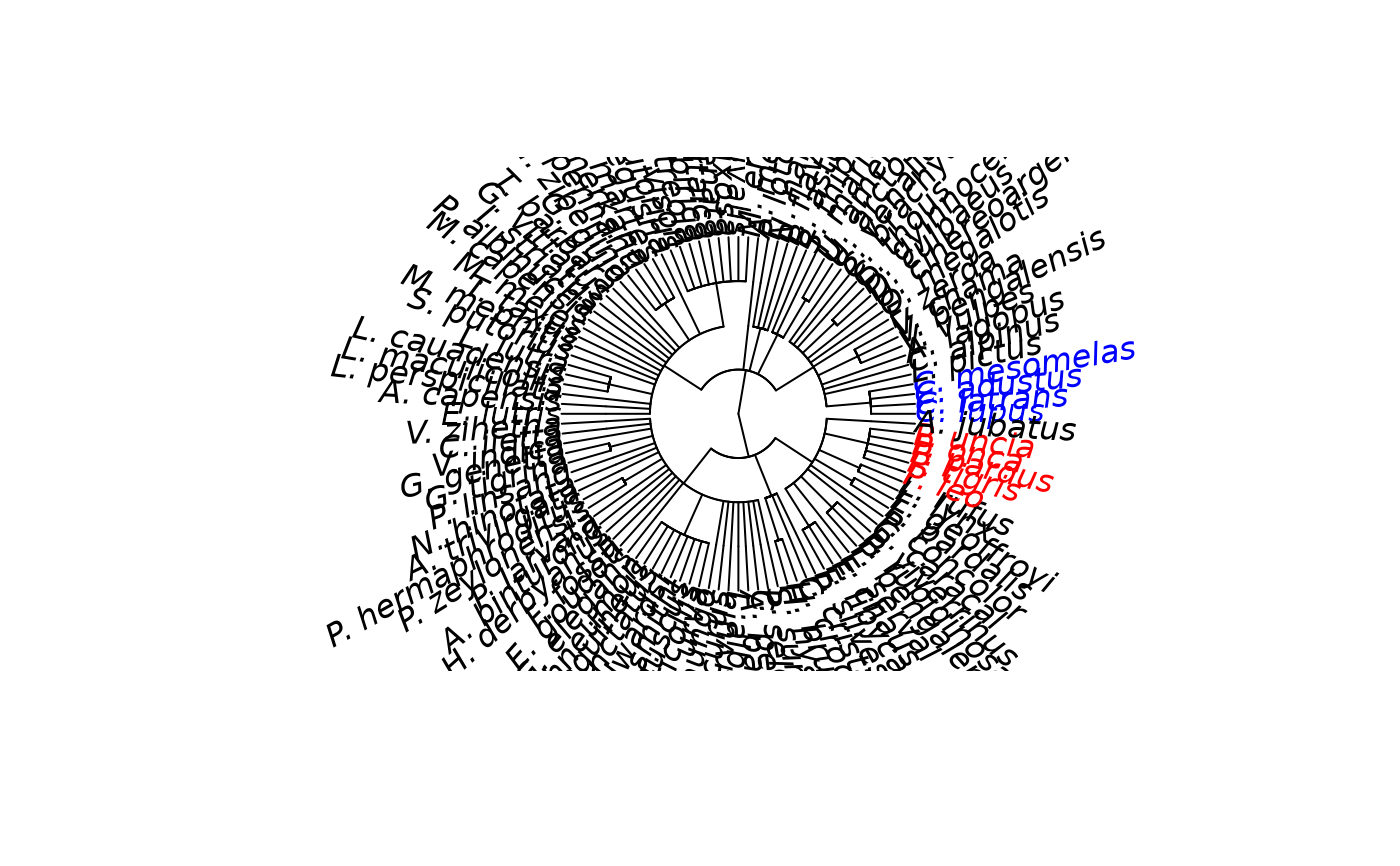CI and RI compute the Consistency Index (CI) and Retention
Index (RI).
Details
The Consistency Index is defined as minimum number of changes divided by the number of changes required on the tree (parsimony score). The Consistency Index is equal to one if there is no homoplasy. And the Retention Index is defined as $$RI = \frac{MaxChanges - ObsChanges}{MaxChanges - MinChanges}$$
Examples
example(as.phylo.formula)
#>
#> as.ph.> data(carnivora)
#>
#> as.ph.> frm <- ~SuperFamily/Family/Genus/Species
#>
#> as.ph.> tr <- as.phylo(frm, data = carnivora, collapse=FALSE)
#>
#> as.ph.> tr$edge.length <- rep(1, nrow(tr$edge))
#>
#> as.ph.> plot(tr, show.node.label=TRUE)
 #>
#> as.ph.> Nnode(tr)
#> [1] 83
#>
#> as.ph.> ## compare with:
#> as.ph.> Nnode(as.phylo(frm, data = carnivora, collapse = FALSE))
#> [1] 83
lab <- tr$tip.label
lab[79] <- "Herpestes fuscus"
tr$tip.label <- abbreviateGenus(lab)
X <- matrix(0, 112, 3, dimnames = list(tr$tip.label, c("Canis", "Panthera",
"Canis_Panthera")))
desc_canis <- Descendants(tr, "Canis")[[1]]
desc_panthera <- Descendants(tr, "Panthera")[[1]]
X[desc_canis, c(1,3)] <- 1
X[desc_panthera, c(2,3)] <- 1
col <- rep("black", 112)
col[desc_panthera] <- "red"
col[desc_canis] <- "blue"
X <- phyDat(X, "USER", levels=c(0,1))
plot(tr, "f", tip.color=col)
#>
#> as.ph.> Nnode(tr)
#> [1] 83
#>
#> as.ph.> ## compare with:
#> as.ph.> Nnode(as.phylo(frm, data = carnivora, collapse = FALSE))
#> [1] 83
lab <- tr$tip.label
lab[79] <- "Herpestes fuscus"
tr$tip.label <- abbreviateGenus(lab)
X <- matrix(0, 112, 3, dimnames = list(tr$tip.label, c("Canis", "Panthera",
"Canis_Panthera")))
desc_canis <- Descendants(tr, "Canis")[[1]]
desc_panthera <- Descendants(tr, "Panthera")[[1]]
X[desc_canis, c(1,3)] <- 1
X[desc_panthera, c(2,3)] <- 1
col <- rep("black", 112)
col[desc_panthera] <- "red"
col[desc_canis] <- "blue"
X <- phyDat(X, "USER", levels=c(0,1))
plot(tr, "f", tip.color=col)
 # The first two sites are homoplase free!
CI(tr, X, sitewise=TRUE)
#> [1] 1.0 1.0 0.5
RI(tr, X, sitewise=TRUE)
#> [1] 1.000 1.000 0.875
# The first two sites are homoplase free!
CI(tr, X, sitewise=TRUE)
#> [1] 1.0 1.0 0.5
RI(tr, X, sitewise=TRUE)
#> [1] 1.000 1.000 0.875
